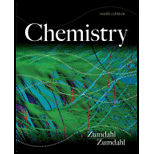
Concept explainers
(a)
Interpretation: The authenticity of the given statement is to be determined.
Concept introduction: The alkali metals occur in the combined state and occur in the minerals in the earth’s crust.
The melting point of gallium is
Reaction of calcium with water is,
Reaction of aluminum trichloride with water is,
Lithium reacts in the presence of oxygen as,
To determine: The authenticity of the statement, “The alkali metals are found in the earth’s crust in the form of pure elements.”
(b)
Interpretation: The authenticity of the given statement is to be determined.
Concept introduction: The alkali metals occur in the combined state and occur in the minerals in the earth’s crust.
The melting point of gallium is
Reaction of calcium with water is,
Reaction of aluminum trichloride with water is,
Lithium reacts in the presence of oxygen as,
To determine: The authenticity of the statement, “Gallium has one of the highest melting points known for metals.”
(c)
Interpretation: The authenticity of the given statement is to be determined.
Concept introduction: The alkali metals occur in the combined state and occur in the minerals in the earth’s crust.
The melting point of gallium is
Reaction of calcium with water is,
Reaction of aluminum trichloride with water is,
Lithium reacts in the presence of oxygen as,
To determine: The authenticity of the statement, “When calcium reacts with water, one of the product is
(d)
Interpretation: The authenticity of the given statement is to be determined.
Concept introduction: The alkali metals occur in the combined state and occur in the minerals in the earth’s crust.
The melting point of gallium is
Reaction of calcium with water is,
Reaction of aluminum trichloride with water is,
Lithium reacts in the presence of oxygen as,
To determine: The authenticity of the statement, “When
(e)
Interpretation: The authenticity of the given statement is to be determined.
Concept introduction: The alkali metals occur in the combined state and occur in the minerals in the earth’s crust.
The melting point of gallium is
Reaction of calcium with water is,
Reaction of aluminum trichloride with water is,
Lithium reacts in the presence of oxygen as,
To determine: The authenticity of the statement, “Lithium reacts in the presence of excess oxygen gas to form lithium peroxide.”
Want to see the full answer?
Check out a sample textbook solution
Chapter 20 Solutions
Chemistry
 Chemistry: An Atoms First ApproachChemistryISBN:9781305079243Author:Steven S. Zumdahl, Susan A. ZumdahlPublisher:Cengage Learning
Chemistry: An Atoms First ApproachChemistryISBN:9781305079243Author:Steven S. Zumdahl, Susan A. ZumdahlPublisher:Cengage Learning ChemistryChemistryISBN:9781305957404Author:Steven S. Zumdahl, Susan A. Zumdahl, Donald J. DeCostePublisher:Cengage Learning
ChemistryChemistryISBN:9781305957404Author:Steven S. Zumdahl, Susan A. Zumdahl, Donald J. DeCostePublisher:Cengage Learning
 Introductory Chemistry: A FoundationChemistryISBN:9781337399425Author:Steven S. Zumdahl, Donald J. DeCostePublisher:Cengage Learning
Introductory Chemistry: A FoundationChemistryISBN:9781337399425Author:Steven S. Zumdahl, Donald J. DeCostePublisher:Cengage Learning Chemistry & Chemical ReactivityChemistryISBN:9781337399074Author:John C. Kotz, Paul M. Treichel, John Townsend, David TreichelPublisher:Cengage Learning
Chemistry & Chemical ReactivityChemistryISBN:9781337399074Author:John C. Kotz, Paul M. Treichel, John Townsend, David TreichelPublisher:Cengage Learning Chemistry & Chemical ReactivityChemistryISBN:9781133949640Author:John C. Kotz, Paul M. Treichel, John Townsend, David TreichelPublisher:Cengage Learning
Chemistry & Chemical ReactivityChemistryISBN:9781133949640Author:John C. Kotz, Paul M. Treichel, John Townsend, David TreichelPublisher:Cengage Learning





